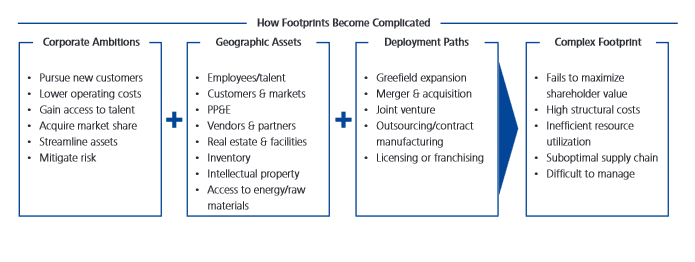From SCDigest's On-Target E-Magazine
- Nov. 2, 2015 -
Supply Chain News: Being Smart about Expanding Your Global Manufacturing Footprint
New Expansions Must be Based on Understanding the Total Network, and the Assessment Must be an Increasingly Dynamic Process
SCDigest Editorial Staff
The desire to reach new markets and leverage global talent drives many manufacturers to expand globally, but the result is often "footprint" complexity. Optimization of that footprint is generally the better course than just expansion.
SCDigest Says: |
 |
One of the greatest impediments to global greenfield expansion is the availability of leaders to conduct knowledge transfer and run new facilities. |
|
What Do You Say?
|
|
|
|
That commonsense observation really summarizes a new report from Deloitte and MAPI - The Manufacturing Alliance, based in part on a survey of executives at global manufacturers.
As shown in the graphic below from the report, the road to a complex and costly footprint is often paved with the best intentions, but the confluence of a company's global strategies, a large number of facilities, and several types of footprint expansion often lead to networks that are high in total costs and difficult to manage.
The report notes that "In recent decades, many manufacturers expanded rapidly and deployed geographic assets in pursuit of singular objectives - to either increase revenues, or reduce costs, or mitigate risk, or gain access to talent. This linear deployment, combined with rapidly changing economic conditions, can put many manufacturers at risk of having a misaligned footprint."
The enterprise manufacturing footprint is of course a key driver of overall corporate performance. When the footprint is optimized, the report notes, a manufacturer can strike the right balance between reducing operating costs, generating new revenue, and attracting and retaining talent.
"In an optimized footprint state, corporate strategies and market realities are better aligned with geographic variables, which can better position the company to deliver enhanced shareholder value," the report adds.
Re-optimizing the network can drive significant improvements in a number of operations areas, according to the report, as listed below:
• Supply chain and logistics costs: 7-10% improvement
• Labor productivity: 10-20% improvement
• Facilities/real estate: 15-20% low costs
• Taxes and incentives: 10-20% improvement
All told, that of course would add to a significant improvement in the bottom line.
How Supply Chain Network Complexity Grows

Source: Deloitte and MAPI
(Manufacturing Article Continued Below)
|